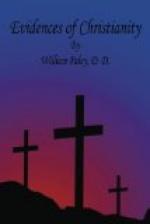III. Clement of Alexandria wrote short explications of many books of the Old and New Testament. (Lardner, Cred. vol. ii. p. 462.)
IV. Tertullian appeals from the authority of a later version, then in use, to the authentic Greek. (Lardner, Cred. vol. ii. p. 638.)
V. An anonymous author, quoted by Eusebius, and who appears to have written about the year 212, appeals to the ancient copies of the Scriptures, in refutation of some corrupt readings alleged by the followers of Artemon. (Lardner, Cred. vol. iii. p. 46.)
VI. The same Eusebius, mentioning by name several writers of the church who lived at this time, and concerning whom he says, “There still remain divers monuments of the laudable industry of those ancient and ecclesiastical men,” (i. e. of Christian writers who were considered as ancient in the year 300,) adds, “There are, besides, treatises of many others, whose names we have not been able to learn, orthodox and ecclesiastical men, as the interpretations of the Divine Scriptures given by each of them show.” (Lardner, Cred. vol. ii. p. 551.)
VII. The last five testimonies may be referred to the year 200; immediately after which, a period of thirty years gives us Julius Africanus, who wrote an epistle upon the apparent difference in the genealogies in Matthew and Luke, which he endeavours to reconcile by the distinction of natural and legal descent, and conducts his hypothesis with great industry through the whole series of generations. (Lardner, Cred. vol. iii. p. 170.)
Ammonius, a learned Alexandrian, who composed, as Tatian had done, a harmony of the four Gospels, which proves, as Tatian’s work did, that there were four Gospels, and no more, at this time in use in the church. It affords also on instance of the zeal of Christians for those writings, and of their solicitude about them. (Lardner, Cred. vol. iii. p. 122.)
And, above both these, Origen, who wrote commentaries, or homilies, upon most of the books included in the New Testament, and upon no other books but these. In particular, he wrote upon Saint John’s Gospel, very largely upon Saint Matthew’s, and commentaries, or homilies, upon the Acts of the Apostles. (Lardner, Cred. vol. iii. pp. 352, 192, 202 & 245.)
VIII. In addition to these, the third century likewise contains—Dionysius of Alexandria, a very learned man, who compared, with great accuracy, the accounts in the four Gospels of the time of Christ’s resurrection, adding a reflection which showed his opinion of their authority: “Let us not think that the evangelists disagree or contradict each other, although there be some small difference; but let us honestly and faithfully endeavour to reconcile what we read.” (Lardner, Cred. vol. iv. p. 166.)
Victorin, bishop of Pettaw, in Germany, who wrote comments upon Saint Matthew’s Gospel. (Lardner, Cred. vol. iv. p. 195.)
Lucian, a presbyter of Antioch; and Hesychius, an Egyptian bishop, who put forth editions of the New Testament.




